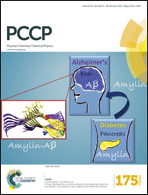The new insight into the structure–activity relation of Pd/CeO2–ZrO2–Nd2O3 catalysts by Raman, in situ DRIFTS and XRD Rietveld analysis†
Abstract
Pd/CeO2–ZrO2–Nd2O3 (CZN) catalysts with different CeO2/ZrO2 molar ratios were synthesized and have been characterized by multiple techniques, e.g. XRD in combination with Rietveld refinement, UV-Raman, XPS and in situ DRIFTS. The XRD pattern of CZN with CeO2/ZrO2 molar ratios ≥1/2 can be indexed satisfactorily to the fluorite structure with a space group Fm![[3 with combining macron]](https://www.rsc.org/images/entities/char_0033_0304.gif) m, while the XRD patterns of CZ12 only display diffraction peaks of the tetragonal phase (S.G. P42/nmc). Nd addition can effectively stabilize the cubic structure of the CZN support and increase the enrichment of defect sites on the surface, which may be related to the better catalytic activity of Pd/CZN12 catalysts compared with Pd/CZ12. The presence of moderate ZrO2 can increase the concentration of O* active species, leading to accelerate the formation of nitrate species and thus enhance the catalytic activity of NOx and HC elimination. The Pd-dispersion decreases with the increasing Zr content, leading to the decreased CO catalytic activity, especially for the aged catalysts. The change regularity of the OSC value is almost the same with the in situ dynamic operational window, demonstrating that the in situ dynamic operational window is basically affected by the OSC value.
m, while the XRD patterns of CZ12 only display diffraction peaks of the tetragonal phase (S.G. P42/nmc). Nd addition can effectively stabilize the cubic structure of the CZN support and increase the enrichment of defect sites on the surface, which may be related to the better catalytic activity of Pd/CZN12 catalysts compared with Pd/CZ12. The presence of moderate ZrO2 can increase the concentration of O* active species, leading to accelerate the formation of nitrate species and thus enhance the catalytic activity of NOx and HC elimination. The Pd-dispersion decreases with the increasing Zr content, leading to the decreased CO catalytic activity, especially for the aged catalysts. The change regularity of the OSC value is almost the same with the in situ dynamic operational window, demonstrating that the in situ dynamic operational window is basically affected by the OSC value.


 Please wait while we load your content...
Please wait while we load your content...